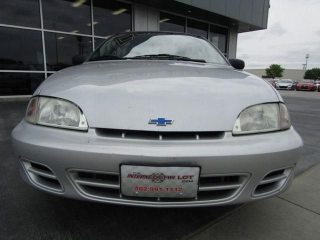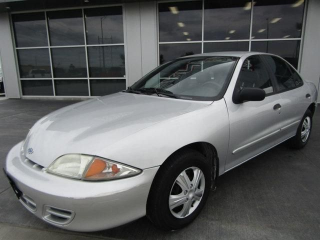The Good
The 2002 Chevrolet Cavalier offered strong value through its low purchase price and economical ownership, appealing greatly to practical buyers. Its decent fuel efficiency and straightforward mechanics translated to affordable maintenance and running costs. Emotionally, it provided accessible independence and reliable transportation, making it a popular choice for first-time car owners seeking simplicity and dependability without breaking the bank.
The Bad
Known weaknesses for the 2002 Chevrolet Cavalier include a somewhat dated and plasticky interior design, uninspired performance from its base engine, and some common mechanical issues. Owners should watch out for intake manifold gasket failures (especially on earlier 2.2L OHV engines, though less common on the Ecotec), premature brake wear, and various electrical gremlins like faulty gauges or power accessories. Rust can also be a significant issue in colder climates.
2002 Chevrolet Cavalier: Quick Overview
- Engine Options:
The primary engine was the 2.2L Ecotec L61 inline-4. Some early production 2002 Z24 models might have still featured the older 2.4L Twin Cam LD9 inline-4 engine before a full transition to the Ecotec across the lineup. - Horsepower:
- 2.2L Ecotec L61: 140 hp @ 5600 rpm.
- 2.4L Twin Cam LD9 (if present in Z24): 150 hp @ 6000 rpm.
- Fuel Economy (estimated):
- 2.2L Ecotec with 5-speed manual: Approximately 23 MPG city / 32 MPG highway.
- 2.2L Ecotec with 4-speed automatic: Approximately 22 MPG city / 30 MPG highway.
- 0-60 Times:
- 2.2L Ecotec: Roughly 8.5-9.5 seconds, depending on transmission and specific vehicle.
- 2.4L Twin Cam (Z24): Roughly 8.0-8.5 seconds.
- Towing Capacity: The 2002 Cavalier was not designed or typically rated for significant towing. Any towing capacity would be minimal, generally under 1,000 lbs, and often not recommended by Chevrolet.
- Trim-Level Features:
- Base: This entry-level trim was very spartan, featuring manual windows and locks, an AM/FM radio, basic cloth upholstery, and steel wheels with covers. It emphasized economy.
- LS: A step up, the LS added more common conveniences. These typically included air conditioning, power windows and locks, a tilt steering wheel, upgraded cloth seating, and often a CD player as an option or standard. Cruise control was also frequently found on the LS.
- Z24: The sporty variant, the Z24 offered a more performance-oriented experience. It came with the more powerful engine option (initially the 2.4L, then the 2.2L Ecotec with a sportier tune), a sport-tuned suspension, distinct alloy wheels, fog lights, a mild body kit, sport seats, and often a leather-wrapped steering wheel and shifter for a more engaging feel.
2002 Chevrolet Cavalier Specifications
Vehicle Information
| Year | 2002 |
| Make | Chevrolet |
| Model | Cavalier |
| Trim | - |
| Style | Coupe |
| Type | Coupe |
| Category | Compact Car |
Manufacturing Details
| Made In | Mexico |
| Manufacturing City | RAMOS ARIZPE |
Dimensions
| Doors | 4-Door |
| Curb Weight | 2676 pounds |
| Gross Vehicle Weight Rating | - |
| Overall Height | 54.70 inches |
| Overall Length | 180.90 inches |
| Overall Width | 67.90 inches |
| Wheelbase Length | 104.10 inches |
| Standard Seating | 5 |
Engine & Performance
| Engine | 2.2-L I4 |
| Engine Size | 2.2L |
| Engine Cylinders | 4 |
| Transmission | 4-Speed Automatic |
| Transmission Type | Automatic |
| Transmission Speeds | 4-Speed |
| Drivetrain | Front-Wheel Drive |
Additional Features
| Anti-Brake System | 4-Wheel ABS |
| Steering Type | Rack & Pinion |
Pricing
| Manufacturer Suggested Retail Price (MSRP) | $14,110 |
| Invoice Price | $13,193 |
| Delivery Charges | $540 |
Vehicle History Report
Specifications
History
Events
History Check
Check
Check
Check
Check
Listings
Recalls
Check
Analysis
What Problems Does the 2002 Chevrolet Cavalier Have?
Another prevalent problem was premature brake wear. Owners frequently reported needing brake pad and rotor replacements, sometimes even within 30,000-40,000 miles, and rear drum brakes could also wear unevenly or seize. Electrical issues were also a consistent complaint. These included faulty gauges (speedometer, fuel gauge), intermittent dashboard lights, issues with power window motors, and failures of power door lock actuators.
The 4-speed automatic transmission (4T40-E/4T45-E) was generally robust, but high-mileage examples could experience hard shifts, delayed engagement, or solenoid problems, eventually necessitating repair or replacement. Power steering pump leaks and noises were also not uncommon as the vehicle aged. Rust, particularly on body panels, rocker panels, and subframe components, became a significant long-term concern for Cavaliers in regions with harsh winters.
Regarding recalls, the 2002 model year was subject to a few, including some related to the ignition switch (though the most significant ignition switch recall affected later model years more prominently, it's worth noting the design lineage), and various minor component issues. Prospective buyers should always check the vehicle's VIN for any outstanding recalls. While generally offering affordable repairs, these recurring issues could add to ownership costs over time if not addressed promptly.
How long will the 2002 Chevrolet Cavalier last?
What Technology & Safety Features are Included?
Built-in Tech & Entertainment: Standard entertainment typically included an AM/FM stereo. Higher trims, such as the LS and Z24, often came with an optional or standard CD player, and in some cases, a cassette player. An upgraded speaker system was an available option. Crucially, there were no integrated navigation systems, Bluetooth connectivity, USB ports, or advanced infotainment screens. Climate control was manually operated.
Driver-Assistance: Modern driver-assistance features like adaptive cruise control, lane-keeping assist, or blind-spot monitoring were non-existent. The primary driver-assistance features were power steering, which was standard, and anti-lock brakes (ABS), which were optional on base models and typically standard on LS and Z24 trims. Traction control was also an available option, primarily on the Z24, to aid in maintaining grip during acceleration in slippery conditions.
Safety Features: Standard safety features for the 2002 Cavalier included dual front airbags for the driver and front passenger. Side airbags were not an option. Three-point seatbelts were standard for outboard seating positions. ABS was a significant safety upgrade and often packaged with other options.
Crash-Test Ratings:
- NHTSA (National Highway Traffic Safety Administration):
- Frontal Driver: 4 out of 5 stars
- Frontal Passenger: 4 out of 5 stars
- Side Impact Driver: 3 out of 5 stars
- Side Impact Rear Passenger: 3 out of 5 stars
- IIHS (Insurance Institute for Highway Safety): The 2002 Cavalier generally received "Acceptable" or "Marginal" ratings in the IIHS's frontal offset crash tests. These ratings were typical for compact cars of its era, indicating adequate but not outstanding crash protection by today's more rigorous standards.
What Colors Options are Available?
2002 Chevrolet Cavalier Prices and Market Value
Today, its used market prices reflect significant depreciation, which is normal for a mass-market compact car of its age. Current used prices typically range from $1,000 for high-mileage or fair-condition examples to $3,000-$4,000 for well-maintained, lower-mileage models. Pristine examples are rare but might fetch slightly more.
Depreciation insights show the Cavalier lost value quickly, primarily due to its economy-car positioning and lack of premium features. Factors affecting its current resale value include overall mechanical condition, absence of significant rust, a clear service history, and the aesthetic condition of both the interior and exterior. While it depreciated heavily, this also means it's now an extremely inexpensive entry into car ownership.
2002 Chevrolet Cavalier Cost of Ownership
2002 Chevrolet Cavalier Fuel Efficiency
2002 Chevrolet Cavalier Safety Rating
NHTSA
IIHS
2002 Chevrolet Cavalier Warranty
Basic
Powertrain
Rust
2002 Chevrolet Cavalier Insurance
reasonable repair costs.
How Does the 2002 Chevrolet Cavalier Compare to Other Coupe?
Performance: The Cavalier's 2.2L Ecotec (140 hp) offered adequate but generally uninspired performance. It was often outclassed by the more refined engines of the Honda Civic (up to 127 hp, but felt more spirited) and Toyota Corolla (125 hp, known for smoothness). The Ford Focus, particularly in its ZTS or SVT trims, offered significantly better handling dynamics and more powerful engine options (up to 170 hp), making it a more engaging drive. Even the Z24 Cavalier (150 hp) struggled to match the overall driving experience of its sportier rivals.
Features: The Cavalier's interior was basic, with hard plastics and limited amenities, even in higher trims. Rivals like the Civic and Corolla typically offered better perceived material quality, more thoughtful ergonomics, and a quieter cabin. The Ford Focus, while also a budget car, often impressed with its ride quality and precise handling for its class. The Cavalier generally lagged in terms of standard or optional features, focusing purely on cost-effectiveness.
Reliability: While the Cavalier was mechanically robust in many ways, it suffered from recurring issues such as intake manifold gasket failures (less on the 2002 Ecotec, but still relevant to the generation), premature brake wear, and electrical problems. This often placed it below the legendary reliability benchmarks set by the Toyota Corolla and Honda Civic, which are known for going hundreds of thousands of miles with minimal major issues. The Ford Focus had its own early model year quirks, but its core mechanicals were generally sound.
Price: This was the Cavalier's strongest suit. It was consistently one of the most affordable cars in its class, often undercutting the Civic, Corolla, and sometimes even the Focus, making it an attractive option for budget-conscious buyers.
Alternatives: For superior long-term reliability and a more refined driving experience, the Honda Civic (7th generation) and Toyota Corolla (9th generation) are better alternatives, though they typically command higher used prices. For better driving dynamics and handling, the 1st generation Ford Focus is an excellent choice. If the absolute lowest purchase price and basic transportation are the only priorities, the Cavalier remains a viable option, provided its known issues are properly addressed.


